Ah, meetings. Can’t do business with ‘em, can’t do business without ‘em.
But have you ever considered the idea that with better meetings, you can do better business?
If you’re in doubt, take it from us. We wrote a guide on it. And it’s true—better meetings do lead to better business, regardless of company, team size, or industry.
But how do you get there? And what does it look like when you do?
Well, we’re going to cover all of that in this article. And we’ll show you that effective meeting management tools don’t just help you manage meetings, they make the entire meeting process—from launching meetings, taking notes, sending out action items, and communicating with other team members—easier and more productive.
The best part? They help you have fewer meetings, too.
Ready to learn more? Here’s everything we’ll cover:
- An overview of meeting management tools
- The problems with single-solution apps for meeting management
- The benefits of streamlining your meeting management solutions
- How to know when you’re ready for a meeting management tool
- The 5 most effective meeting management tools
- How to know which meeting management tool is right for you
Shopping for an online meeting tool? (Or just curious about what to look for?) Grab the free checklist to help you choose the right one for your team or business.
An overview of meeting management tools
Meeting management tools, as you may suspect, are designed to help you manage meetings. Today, these tools typically come in the form of desktop or internet applications, platform technologies, and cloud-based software. They’ve exploded in popularity and prominence over the course of the past 15 years, thanks in large part to the internet and the rise of the tech industry.
And now, with remote work growing at an exceedingly rapid rate, investing in effective meeting management tools is more important than ever before for the day-to-day success of your business.
What meeting management tools are typically used for
These days, there are dozens of tools for just about every aspect of a meeting. Seriously, pick any step in the process and there’s an app for it. There are tools for cloud-based phone calls, interactive video conferencing, messaging, meeting scheduling, note-taking, and on and on and on.
Shameless plug incoming: There are very few tools, if any, quite like RingCentral Office®. Why? Because not only does it manage meetings—it reinvents the way you and your company go about the entire meeting process, from pre- to post-meeting.
We’re going to take a deeper look at why streamlined, connected apps are more effective for meeting management, but first, let’s talk about the problems with single-app solutions.
The problems with single-solution apps for meeting management
There’s nothing wrong with getting a single meeting management app if that’s all your company needs. However, chances are, if you’re at a point where your company needs a meeting management tool, then you’re going to need something that does more than just one thing.
Even if you do just need one aspect of your meetings managed, how long is that going to be the case for? If you plan on growing over the course of the next year, that single tool you invest in could very well be obsolete for you in a matter of mere months. (Or, it could still be effective but not effective enough, requiring you to invest more capital into yet another tool.)
And what happens then? You fall into the trap of buying more and more tools over time, each one with a different purpose, yet no interconnectivity between them.
Add in the accumulating monthly costs, getting everyone in your company trained to use them, and the frustration of having to toggle from tool to tool, and pretty soon your meeting management solutions will be costing you more time and money than they will be saving you time and money.
The problems
#1 Lack of interconnectivity across tools
Without interconnectivity, what good is a meeting? Even if it’s the tech we’re talking about—tech for meetings—but there’s no interconnectivity, then there are going to be issues.
Connection and communication are at the heart of any good meeting. And that has to be reflected in your meeting management tools. If it’s not, you’re going to end up with lackadaisical meetings, mismanaged calendars, and disorganization.
#2 Multiple meeting tools come with high monthly costs
The bills for meeting management tools get costly—fast.
This is high tech we’re talking about, and innovative products aren’t exactly cheap. Nor should they be. With that being said, it’s your responsibility as a business leader to avoid the red by making sound financial choices, and one choice you have is what you invest in for meeting technology.
You—and your bottom line—are better off preparing for the present day and the future by making a bigger upfront investment in an all-in-one meeting management tool (like RingCentral Office), rather than trying to save a few bucks in the short-term by going with a lesser, single-solution tool. Pretty soon those smaller apps will add up and cost more, yet do significantly less, than the streamlined solution.
#3 Training your teams to use new apps is inefficient
Getting your team on board with a new meeting management tool is hard work. Not only do you have to create (or purchase) training materials, but you also have to use precious employee time on training. And if you’re purchasing a new tool every year or so, pretty soon you’re going to be burning a lot of time, money, and resources on training.
And for what? Tools that exist in a single app like RingCentral Office could be learned in half the time on the same platform.
#4 Having multiple single-solution apps slows productivity
Computers may have increased productivity, and the internet sure has, but when there’s too much technology for any given employee to learn and operate, trouble arises.
When it comes to meetings, they’re hardly manageable when the tools designed for them are impossible to manage themselves. How can we realistically expect employees to be productive when they have to launch a meeting on one app, ask a team member to join said meeting in a different app, and take meeting notes in yet another app? We can’t. It’s simply unfair to do so.
Plus, too much tech frustration and operational inefficiency will jeopardize employee satisfaction, and, if unaccounted for, drive your team members to job sites in search of something else.
The solution
Invest in an all-in-one meeting management tool
It sounds straightforward and easy. It’s not.
With an ocean of apps to choose from, it’s hard to know which one is right for your company. It’s especially difficult to find the absolutely best tool that doesn’t just manage meetings, but helps your business have more productive—and fewer—ones.
The key is to be patient. You need to understand that it’s going to take a lot of time to research and demo a variety of meeting management tools before you find the perfect one for you.
Yet, regardless of how long it takes to find, the one thing you should be looking for in your meeting management solution is consolidation.
In other words, the best app for you is going to be one that can streamline all of your meeting functions and technology, bringing it all together on a single platform that is easy to use with a clean user interface and intuitive user experience.
The benefits of streamlining your meeting management solutions
When all of your meeting management tools are on one platform, it becomes incredibly simple for you and your teams to communicate with each other, schedule meetings, create and distribute agendas, share notes, and manage action items.
Essentially, all of the core functions of meetings—including pre- and post-meeting tasks—should happen on a single, streamlined tool.
For example, take RingCentral. At its core, RingCentral is a communications tool. Yet with immense plug-in and add-on capabilities (including integrations with Microsoft Outlook and Gmail), you’re able to turn RingCentral into the best meeting management tool in the world.
All of the sudden, your communication tool has now become your all-in-one meeting management tool. With the appropriate add-on in place, RingCentral now makes it super easy to schedule RingCentral meetings in the native calendar app, it improves productivity (and sanity) by reducing the number of apps your employees need to use on any given day, and it enables you to track and manage all business communications from a single place.
Not to mention all of the irreplaceable things RingCentral already does for you—from organizing workflows with team messaging, file sharing, and task management to making personal, productive meetings via HD audio and video a reality.
This all sounds great, right?
It is, and our case studies are evidence of how much RingCentral can help a business, but that doesn’t mean your company is necessarily ready for it—or any meeting management tool for that matter.
How to know when you’re ready for a meeting management tool
“Meeting management” may sound beautiful and make your eyes light up, but that doesn’t mean the technology designed to do it will help your company.
At least, maybe not yet.
It all really depends on the size of your business. For companies that only have a couple of meetings every day, a meeting management solution probably isn’t best. It’s too costly and time-intensive to justify implementation. Plus, it wouldn’t get enough usage to make it worth it.
The same goes for businesses that are on the smaller side, have tried out a few meeting management tools in the past, and are now trying to reimagine their meeting experience. No meeting management tool is going to reinvent the way meetings are done. It might seem like tech can do anything, but trust us, no technology can fix truly poor meeting habits or quell big egos. That type of work has to be done by a company’s people, not their technology.
So, with that being said, you’ll know you’re ready for a meeting management tool when:
- Meetings take up half of your day, every day of the week
- You can’t function optimally at your job without being able to schedule, launch, and conduct meetings in the click of a button or two
- Your employees begin complaining that they’re in too many meetings
- Meetings feel more like a chore and less like an opportunity to get some work done
- Nothing good comes out of meetings (e.g., no concrete action items, decisions made, etc.)
If you’re experiencing any of these things—perhaps you’re experiencing a few—then the next section is for you, as we feature the most effective meeting management tools.
The 5 most effective meeting management tools
When it comes to meeting management, there are plenty of tools to do plenty of things. In fact, there are so many that we had to break down our list of most effective meeting management tools into different categories.
Ready? Let’s dive in.
Best meeting management tool for scheduling
Calendly
Calendly connects with up to six of your calendars to automatically check availability and help you seamlessly schedule meetings with your team, customers, and prospects:
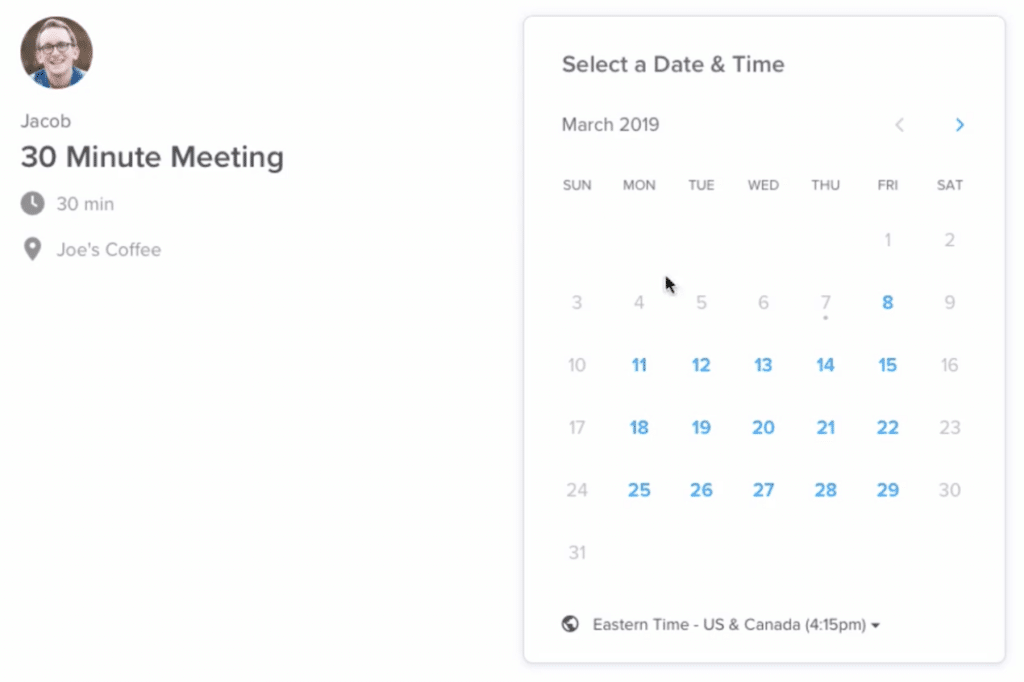
Best meeting management tool for communication
RingCentral Office
An all-in-one workspace for every type of conversation—including video, phone, and messaging—makes RingCentral Office the must-have communication tool for meeting management at any modern business:
Plus, with RingCentral Video built into the app, you can schedule a meeting…
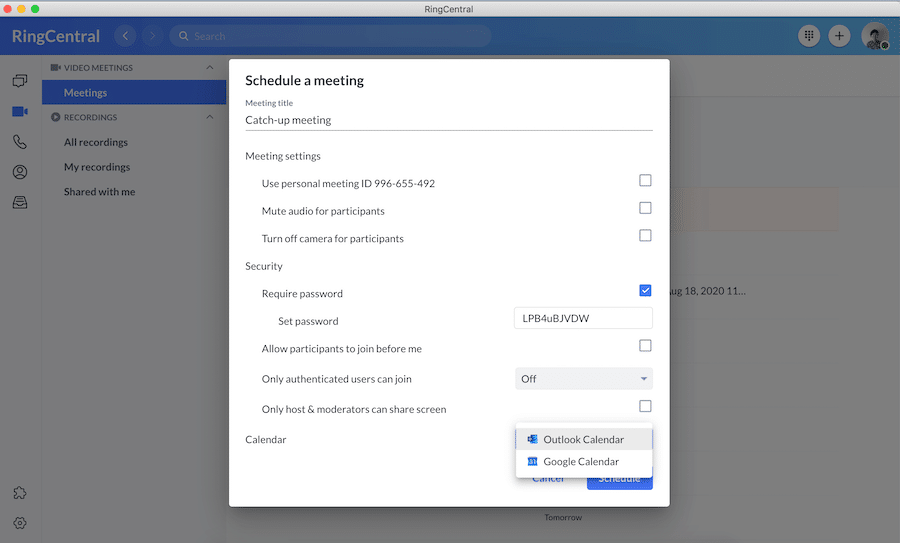
… Join a meeting, and see your meetings for the day in the app in just a matter of moments.
🕹️ Get a hands-on look at how RingCentral helps you have more productive meetings by booking a product tour:
💰 You can also use this calculator to see roughly how much your business could save by using RingCentral to support your team’s communication with each other—and clients.
Best tool for managing large-scale projects between meetings
Trello
Trello uses digital boards, lists, and cards to help teams capture, organize, and track action items. As you might suspect, Trello is helpful in ways that go beyond meetings:
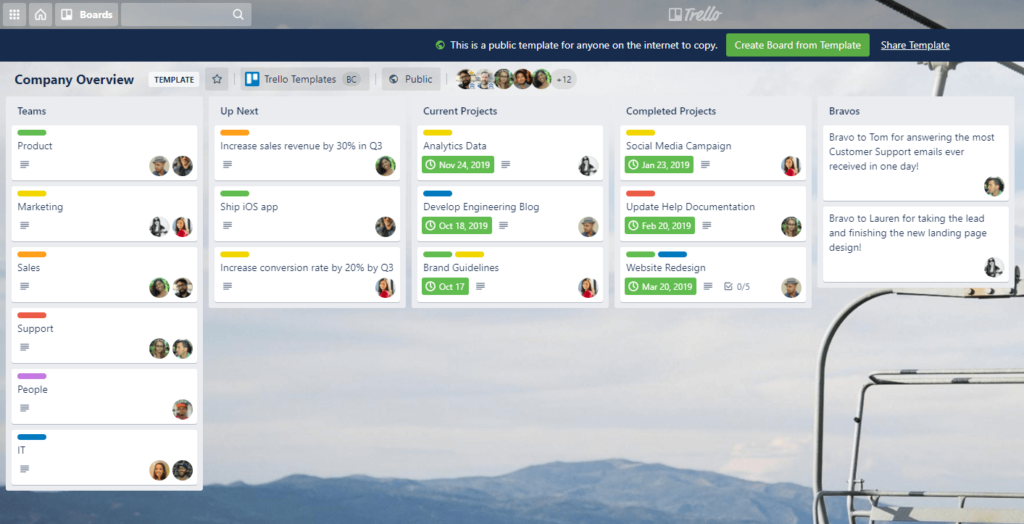
Best note-taking tool to help manage meetings
Notion
Notion is a collaborative and customizable workspace that allows you to not only take meeting notes, but also to organize them in a clear, intuitive folder structure—all within the app:
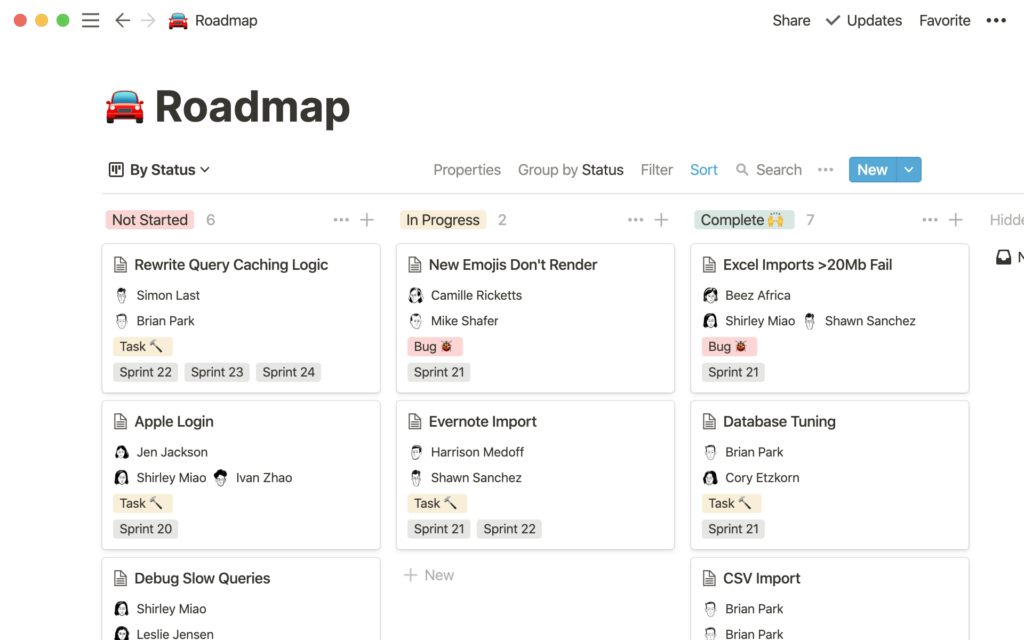
Best agenda creation for meetings
SoapBox
SoapBox enables you and your team to create a shared meeting agenda, take notes during the meeting itself, and then share next steps and action items—all from the same app:
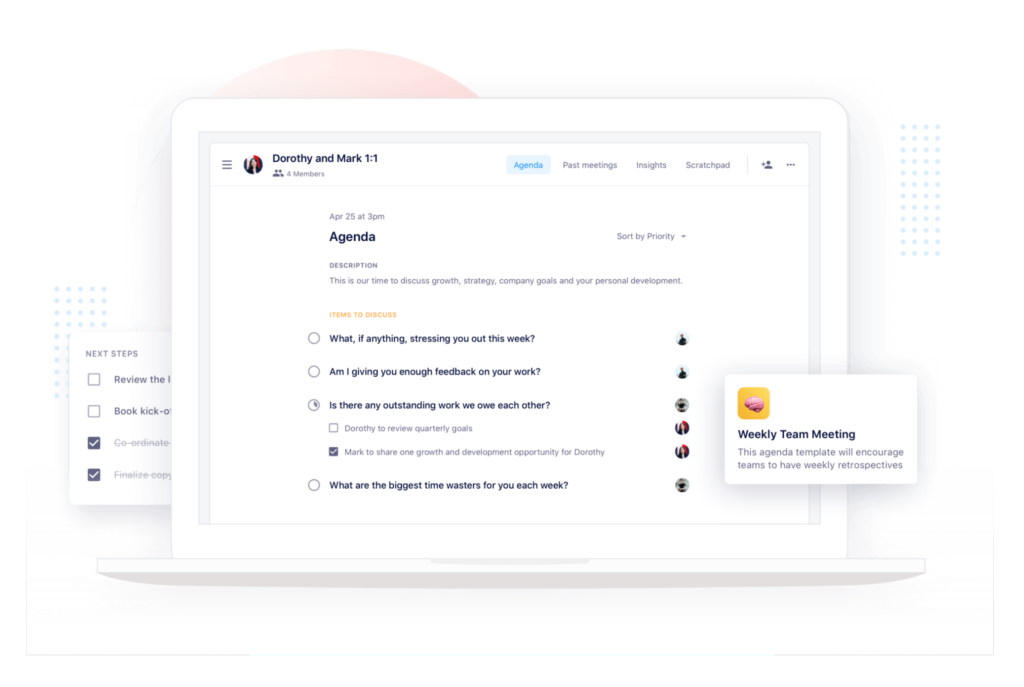
Some video conferencing software will have built-in integrations with calendars so that you can add your agenda right into the invite, so you may not need a separate agenda creation tool!
How to know which meeting management tool is right for you
Now that you’ve seen some of the very best meeting management apps out there, you’re probably wondering which tool is right for you.
It’s not easy figuring that out. Most of the time, there’s more than one meeting management solution you need to truly optimize all your company’s meetings. If that’s the case, then RingCentral Office is your go-to tool since it can handle both the actual conferencing aspect of meetings and also post-meeting follow-ups.
For example, if everyone has their own follow-up tasks to do after a meeting and you want to keep track of everything, you can create a team chat with all the attendees from that meeting with one click in the RingCentral app:

If you think that you’ll need only one solution to your meeting woes, then it’s extremely important that you invest in the right one. Otherwise, your meeting troubles will continue. If that happens, you’ll likely get caught in the trap of buying expensive software that promises to solve the problem, when in reality, it probably only adds to it.
So, to successfully find out which meeting management tool is right for you, we suggest you…
- Take note of every touch point of your company’s current meeting process
- Keep track of pain points in launching a meeting vs. conducting one vs. follow up
- Capture how long each meeting lasts for at least one week
- Make note of how long you think each meeting should have lasted
- Survey your employees about meetings at your company (what works vs. what doesn’t)
- Consolidate the findings, analyze them, and prioritize your meeting management needs
Making the most out of your meeting management tools
We’ve said it before and we’ll say it again: meeting management tools will not fix bad meeting habits.
Your company needs to have productive meetings without a meeting management tool in order to experience even more productive meetings with one. If you begin introducing meeting technology at a company with disorganized, chaotic meetings, then you’re going to be left with even more chaos. And we know you don’t want that. Nobody does.
That’s why, in order to truly make the most out of your meeting management tool, you need to first make sure your company’s meetings are in order. If they are, then maximizing the impact of your meeting management tool all comes down to three things:
- Education about how to use the tool
- Widespread implementation of the tool
- Company-wide commitment to learn by using the tool
If you do these three things, in order, you should be in great shape with your meeting management tool, regardless of what it is. But you have to remember: this is a long-term investment, and progress will be slow. Yet, day-by-day and meeting-by-meeting, you’ll begin to realize the incredible advantage of having a tool that streamlines meetings and makes them more efficient—to the point that, somewhere down the line, you won’t even need to have most of them.
Did someone say fewer meetings? Now that’s something we can all get behind.
Originally published Nov 25, 2020, updated Jul 17, 2024






